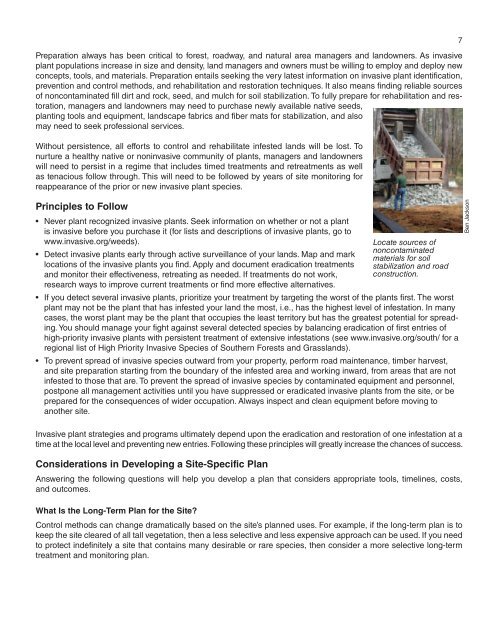A Management Guide for Invasive Plants in Southern Forests James ...
A Management Guide for Invasive Plants in Southern Forests James ...
A Management Guide for Invasive Plants in Southern Forests James ...
- No tags were found...
Create successful ePaper yourself
Turn your PDF publications into a flip-book with our unique Google optimized e-Paper software.
Preparation always has been critical to <strong>for</strong>est, roadway, and natural area managers and landowners. As <strong>in</strong>vasiveplant populations <strong>in</strong>crease <strong>in</strong> size and density, land managers and owners must be will<strong>in</strong>g to employ and deploy newconcepts, tools, and materials. Preparation entails seek<strong>in</strong>g the very latest <strong>in</strong><strong>for</strong>mation on <strong>in</strong>vasive plant identification,prevention and control methods, and rehabilitation and restoration techniques. It also means f<strong>in</strong>d<strong>in</strong>g reliable sourcesof noncontam<strong>in</strong>ated fill dirt and rock, seed, and mulch <strong>for</strong> soil stabilization. To fully prepare <strong>for</strong> rehabilitation and restoration,managers and landowners may need to purchase newly available native seeds,plant<strong>in</strong>g tools and equipment, landscape fabrics and fiber mats <strong>for</strong> stabilization, and alsomay need to seek professional services.Without persistence, all ef<strong>for</strong>ts to control and rehabilitate <strong>in</strong>fested lands will be lost. Tonurture a healthy native or non<strong>in</strong>vasive community of plants, managers and landownerswill need to persist <strong>in</strong> a regime that <strong>in</strong>cludes timed treatments and retreatments as wellas tenacious follow through. This will need to be followed by years of site monitor<strong>in</strong>g <strong>for</strong>reappearance of the prior or new <strong>in</strong>vasive plant species.Pr<strong>in</strong>ciples to Follow• Never plant recognized <strong>in</strong>vasive plants. Seek <strong>in</strong><strong>for</strong>mation on whether or not a plantis <strong>in</strong>vasive be<strong>for</strong>e you purchase it (<strong>for</strong> lists and descriptions of <strong>in</strong>vasive plants, go towww.<strong>in</strong>vasive.org/weeds).• Detect <strong>in</strong>vasive plants early through active surveillance of your lands. Map and marklocations of the <strong>in</strong>vasive plants you f<strong>in</strong>d. Apply and document eradication treatmentsand monitor their effectiveness, retreat<strong>in</strong>g as needed. If treatments do not work,research ways to improve current treatments or f<strong>in</strong>d more effective alternatives.Locate sources ofnoncontam<strong>in</strong>atedmaterials <strong>for</strong> soilstabilization and roadconstruction.• If you detect several <strong>in</strong>vasive plants, prioritize your treatment by target<strong>in</strong>g the worst of the plants first. The worstplant may not be the plant that has <strong>in</strong>fested your land the most, i.e., has the highest level of <strong>in</strong>festation. In manycases, the worst plant may be the plant that occupies the least territory but has the greatest potential <strong>for</strong> spread<strong>in</strong>g.You should manage your fight aga<strong>in</strong>st several detected species by balanc<strong>in</strong>g eradication of first entries ofhigh-priority <strong>in</strong>vasive plants with persistent treatment of extensive <strong>in</strong>festations (see www.<strong>in</strong>vasive.org/south/ <strong>for</strong> aregional list of High Priority <strong>Invasive</strong> Species of <strong>Southern</strong> <strong>Forests</strong> and Grasslands).• To prevent spread of <strong>in</strong>vasive species outward from your property, per<strong>for</strong>m road ma<strong>in</strong>tenance, timber harvest,and site preparation start<strong>in</strong>g from the boundary of the <strong>in</strong>fested area and work<strong>in</strong>g <strong>in</strong>ward, from areas that are not<strong>in</strong>fested to those that are. To prevent the spread of <strong>in</strong>vasive species by contam<strong>in</strong>ated equipment and personnel,postpone all management activities until you have suppressed or eradicated <strong>in</strong>vasive plants from the site, or beprepared <strong>for</strong> the consequences of wider occupation. Always <strong>in</strong>spect and clean equipment be<strong>for</strong>e mov<strong>in</strong>g toanother site.7Ben Jackson<strong>Invasive</strong> plant strategies and programs ultimately depend upon the eradication and restoration of one <strong>in</strong>festation at atime at the local level and prevent<strong>in</strong>g new entries. Follow<strong>in</strong>g these pr<strong>in</strong>ciples will greatly <strong>in</strong>crease the chances of success.Considerations <strong>in</strong> Develop<strong>in</strong>g a Site-Specific PlanAnswer<strong>in</strong>g the follow<strong>in</strong>g questions will help you develop a plan that considers appropriate tools, timel<strong>in</strong>es, costs,and outcomes.What Is the Long-Term Plan <strong>for</strong> the Site?Control methods can change dramatically based on the site’s planned uses. For example, if the long-term plan is tokeep the site cleared of all tall vegetation, then a less selective and less expensive approach can be used. If you needto protect <strong>in</strong>def<strong>in</strong>itely a site that conta<strong>in</strong>s many desirable or rare species, then consider a more selective long-termtreatment and monitor<strong>in</strong>g plan.
















